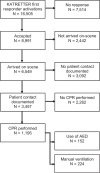Automated and app-based activation of first responders for prehospital cardiac arrest: an analysis of 16.500 activations of the KATRETTER system in Berlin
- PMID: 38124125
- PMCID: PMC10731739
- DOI: 10.1186/s13049-023-01152-3
Automated and app-based activation of first responders for prehospital cardiac arrest: an analysis of 16.500 activations of the KATRETTER system in Berlin
Abstract
Background: Bystander CPR is one of the main independent factors contributing to better survival after out-of-hospital cardiac arrest. Simultaneously, the rate of bystander CPR in Germany is below the European average. First responder applications (apps) contribute to reducing the time period without CPR (no-flow time) until professional help can arrive on-scene.
Methods: The KATRETTER app was introduced in Berlin as one of the first apps in Europe which do not require any medical qualifications to register as a first responder. The activation of volunteer first responders for suspected cardiac arrest cases through the Berlin Emergency Medical Services integrated control center was evaluated based on data collected between 16 Oct 2020 and 16 Oct 2022. Our descriptive analysis includes the number of registered first responders, number of activations, the number and percentages of accepted activations, as well as all reports where first responders arrived at the scene.
Results: As of 15 Oct 2022, a total of 10,102 first responders were registered in the state of Berlin. During this specified period, there were 16.505 activations of the system for suspected out-of-hospital cardiac arrest. In 38.4% of the accepted cases, first responders documented patient contact, and in 34.6% of cases with patient contact, CPR was performed. Only 2% of registered first responders did not have any medical qualifications.
Conclusions: Smartphone-based first responder applications should not be understood as a means of alerting professional help, but rather like a digitally amplified "call for help" in the vicinity of an emergency location. A large number of first responders can be recruited within 24 months, without large-scale public relations work necessary. No qualifications were required to become a first responder, contributing to a low-threshold registration process with the effect of a more widespread distribution of the app and cost reduction during implementation.
Keywords: Bystander CPR; Community first responder; Community response; Crowdsourcing; Dispatcher; Emergency medical services (MeSH); Out-of-hospital cardiac arrest (MeSH); Smart technology.
© 2023. The Author(s).
Conflict of interest statement
The authors declare no competing interests.
Figures





Similar articles
-
myResponder Smartphone Application to Crowdsource Basic Life Support for Out-of-Hospital Cardiac Arrest: The Singapore Experience.Prehosp Emerg Care. 2021 May-Jun;25(3):388-396. doi: 10.1080/10903127.2020.1777233. Epub 2020 Jul 9. Prehosp Emerg Care. 2021. PMID: 32497484
-
Smartphone Activation of Citizen Responders to Facilitate Defibrillation in Out-of-Hospital Cardiac Arrest.J Am Coll Cardiol. 2020 Jul 7;76(1):43-53. doi: 10.1016/j.jacc.2020.04.073. J Am Coll Cardiol. 2020. PMID: 32616162
-
Lay persons alerted by mobile application system initiate earlier cardio-pulmonary resuscitation: A comparison with SMS-based system notification.Resuscitation. 2017 May;114:73-78. doi: 10.1016/j.resuscitation.2017.03.003. Epub 2017 Mar 6. Resuscitation. 2017. PMID: 28268186
-
Enhancing citizens response to out-of-hospital cardiac arrest: A systematic review of mobile-phone systems to alert citizens as first responders.Resuscitation. 2020 Jul;152:16-25. doi: 10.1016/j.resuscitation.2020.05.006. Epub 2020 May 11. Resuscitation. 2020. PMID: 32437783 Free PMC article.
-
Community first responders for out-of-hospital cardiac arrest in adults and children.Cochrane Database Syst Rev. 2019 Jul 19;7(7):CD012764. doi: 10.1002/14651858.CD012764.pub2. Cochrane Database Syst Rev. 2019. PMID: 31323120 Free PMC article.
Cited by
-
Facing the Obstacles of OHCA Response: Integrating First Responders With Drone Delivery for AED Deployment.JACC Adv. 2024 Jun 25;3(7):101032. doi: 10.1016/j.jacadv.2024.101032. eCollection 2024 Jul. JACC Adv. 2024. PMID: 39130042 Free PMC article.
-
Innovative Training Strategies for Public Response to Out-of-Hospital Cardiac Arrest: A Scoping Review.Risk Manag Healthc Policy. 2025 May 19;18:1635-1650. doi: 10.2147/RMHP.S519931. eCollection 2025. Risk Manag Healthc Policy. 2025. PMID: 40416834 Free PMC article. Review.
-
Access to automated external defibrillators and first responders: Associations with socioeconomic factors and income inequality at small spatial scales.Resusc Plus. 2024 Feb 1;17:100561. doi: 10.1016/j.resplu.2024.100561. eCollection 2024 Mar. Resusc Plus. 2024. PMID: 38328745 Free PMC article.
References
-
- Gräsner J-T, Herlitz J, Tjelmeland IBM, et al. Epidemiologie des Kreislaufstillstands in Europa. Notfall + Rettungsmedizin. 2021;24:346–366. doi: 10.1007/s10049-021-00884-y. - DOI
-
- Deutsche Gesellschaft für Anästhesiologie und Intensivmedizin e.V. (DGAI): Jahresbericht Außerklinische Reanimation 2021 des Deutschen Reanimationsregisters. 2021.
MeSH terms
LinkOut - more resources
Full Text Sources
Medical
Research Materials
Miscellaneous

